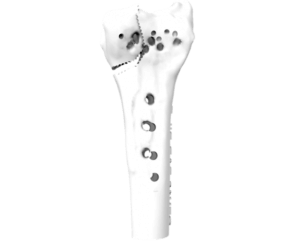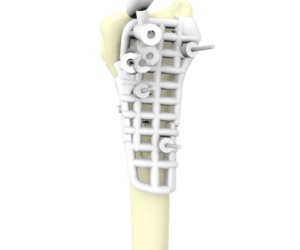Surgeon Calls On Materialise Mimics Software to Create 3D Printed Patient-Specific Surgical Guides for a Complex Wrist Osteotomy
 Any type of surgery, from the simplest to the more complex, brings potential risks with it; any number of things can go wrong. That’s why Alistair Phillips, a Consultant Orthopaedic Surgeon specializing in the hand, wrist, and elbow who works at Spire Southampton Hospital and the Hampshire Hand Surgery Clinic, has a personal philosophy to treat his patients without surgery if at all possible. He only offers surgery as a medical solution if he honestly believes that it will improve a patient’s condition, with minimal risk involved. His goal is to keep patients in the hospital for as short a time as possible, which I’ve learned is often the goal of other physicians as well – the longer you stay in the hospital, the greater the risk of infection. 3D printing can often help with this goal, but not every surgeon goes straight to this technology as a first option.
Any type of surgery, from the simplest to the more complex, brings potential risks with it; any number of things can go wrong. That’s why Alistair Phillips, a Consultant Orthopaedic Surgeon specializing in the hand, wrist, and elbow who works at Spire Southampton Hospital and the Hampshire Hand Surgery Clinic, has a personal philosophy to treat his patients without surgery if at all possible. He only offers surgery as a medical solution if he honestly believes that it will improve a patient’s condition, with minimal risk involved. His goal is to keep patients in the hospital for as short a time as possible, which I’ve learned is often the goal of other physicians as well – the longer you stay in the hospital, the greater the risk of infection. 3D printing can often help with this goal, but not every surgeon goes straight to this technology as a first option.
Phillips has a sub-specialist interest in using local anesthetics, rather than putting patients completely under, and has developed nearly painless injection techniques, due to his simple principle of treating patients as he himself would like to be treated.
“I also provide a full service for all other hand, wrist and elbow problems,” Phillips explained. “I work very closely with some excellent hand therapists and believe that, although surgery has its place, in hand problems particularly, therapy can be often as effective in treating some conditions. I will only operate if I feel it as close to a guarantee of success as I can make.”
All of this goes to show that if Phillips performs surgery, he’ll do whatever he can to make sure it goes smoothly. He receives a lot of referral cases for patients needing elbow surgery and trauma reconstruction, many times after having been in a car accident. A case that was recently referred to him was a young man with a distal radius wrist fracture. After Phillips performed surgery, a complication arose – the patient’s lunate fossa began to deteriorate, which caused intra-articular damage; the lunate bone is actually the most frequently dislocated carpal bone. This complication meant that the patient was in a lot of pain, and would need a second surgery. So Phillips called in the cavalry for a 3D approach to the impending wrist osteotomy.
He contacted Materialise, because of how complex the case was. First, CT scans were made of the patient’s wrists, both the fractured one and the healthy one. Clinical engineers with Materialise then segmented the images from the CT scans, using Materialise Mimics software. Materialise Mimics can be used to:- import JPEG, TIFF, DICOM, BMP, x-ray, or raw image data
- efficiently create accurate, patient-specific 3D models
- perform dedicated anatomical analysis
- virtually simulate surgery
- export 3D models for design, 3D analysis, FEA meshing, or 3D printing
The specialized software has been used in human cases, such as the prediction of thyroplasty success for transgender women, and even in researching cases from the past, like dinosaurs and a 430,000-year-old murder mystery. In this case, once the wrist images had been segmented using the software, Materialise engineers used the 3D wrist reconstruction to plan out the optimal cuts for the wrist osteotomy, and then got to work designing the patient-specific surgical guides, so Phillips would know where exactly on the bone he needed to cut. The guides were then 3D printed and shipped to the Hampshire Hand Surgery Clinic.
- Outcome model
- Osteotomy plan
- Osteotomy guide, Hampshire Hand Surgery Clinic case
The wrist osteotomy in January went very smoothly, and the patient recovered well, with only minimal pain this time. Just a week after his surgery, Phillips was able to transfer the patient to a removable splint, and wrote in a blog post that although the patient wouldn’t be able to lift anything heavier than a pen for a while, everything seemed to be fine. You can take a look at how well the patient was able to move his wrist one week post-op in this short video:
Discuss in the Wrist Surgery forum at 3DPB.com. [Source: Materialise]
Podcast: Play in new window | Download
Subscribe to Our Email Newsletter
Stay up-to-date on all the latest news from the 3D printing industry and receive information and offers from third party vendors.
You May Also Like
3D Printing Financials: Fathom Struggles in Financial Quicksand During Critical Transition
Facing a year of key transitions and financial pressures, Fathom (Nasdaq: FTHM) has filed its annual report for 2023 with the U.S. Securities and Exchange Commission (SEC). The document outlines...
Latest Earnings Overview for Australian 3D Printing Firms Titomic and AML3D
Australian 3D printing manufacturing firms Titomic (ASX: TTT) and AML3D (ASX: AL3) reported their financial results for the period from July to December 2023, marking the first half of their...
3D Printing Webinar and Event Roundup: April 7, 2024
Webinars and events in the 3D printing industry are picking back up this week! Sea-Air-Space is coming to Maryland, and SAE International is sponsoring a 3D Systems webinar about 3D...
3D Printing Financials: Unpacking Farsoon and BLT’s 2023 Performance
In the Chinese 3D printing industry, two companies, Farsoon (SHA: 688433) and Bright Laser Technologies, or BLT (SHA: 688333), have recently unveiled their full-year earnings for 2023. Farsoon reported increases...



![[Image: Mr. Alistair Phillips]](https://editorial.3dprint.com/wp-content/uploads/2017/02/Distal-radius-wrist-fracture-Xrays.png)
































